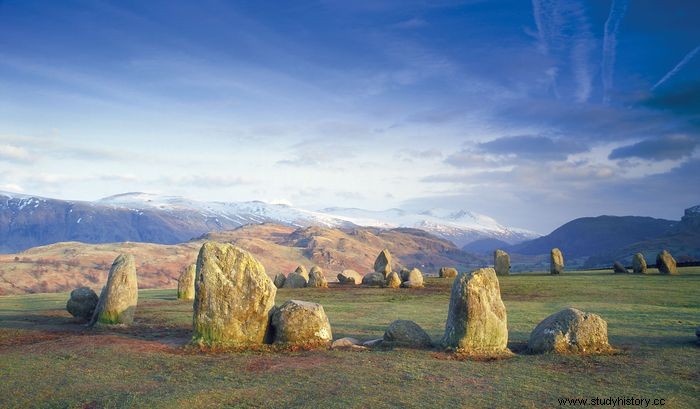Cumberland , Historic County, Far Northwest England , to the north of Scotland , east of historic counties Northumberland and Durham and south of historic counties Westmorland and Lancashire limited . Cumberland is currently part of the county Cumbria .
Cumberland is on the north west coast of England overlooking the Solway Firth and the Irish Sea . To the south a narrow coastal plain rises to the Cumbrian Mountains, which reach 978 meters at Scafell Pike, the highest point in England. These mountains surround the scenic Lake District , part of which is in Cumberland. The lower part of the fertile Valley of Eden is in the center of the county. The historic county seat (seat) Carlisle stands where this valley widens to meet the coastal plain to the north. To the east, the Pennines the border with Northumbria and Durham.
Proof of The Cast from the Bronze Age includes stone circles, specifically Long Meg and Her Daughters (near Little Selkeld) and Castlerigg Circle (near Keswick). Between 122 and 126 v. Chr. built the Roman Emperor Hadrian built the great wall complex between Wallsend in Northumberland and Bowness-on-Solway in Cumberland ( Hadrian's Wall ). Roman occupation was primarily military, and Carlisle, then called Luguvallium, was the main civilian settlement. St. Ninian brought Christianity to Cumberland in the late 4th century. 7th century kingdom Northumbria conquered the area then known as Cumbria, whose people were Celtic-speaking Britons. The name Cumbria, like Cambria, is a Latinised version of Welsh Cymry or Cymru (now exclusively for Wales).

Danes and Norsemen from Ireland or the Isle of Man raided Cumbria in the 9th century. 945 devastated Edmund I. all "Cumbraland" - first mentioned by that name - and gave them to the Scottish king Malcolm I. in exchange for a promise of military support. (The area of Cumbraland at that time is believed to have comprised the south-west of what is now Scotland and the region that became Cumberland.) The Earls of Northumbria controlled one in the first half of the 11th century Part of the county, but in 1068 the King of Scots had occupied the territory, almost all of which was outside des kingdom William the Conqueror layers . 1092 reigned a vassal of the Scottish king Carlisle when it was ruled by king William II was captured (William Rufus), who repaired the city, ordered the building of Carlisle Castle and sent settlers around the land claim. Place names with the addition from after a Norman personal name reflect the Immigration from the South at this time. The country was briefly retaken from the Scots, but the historic county of Cumberland, founded in 1177, remained a part of England.
Because of its border location, Cumberland was the scene of constant disputes and much bloodshed. Although many residents of the county the Stuart thing during the English civil wars Active support for the Jacobite uprisings of 1715 and 1745 were limited. It was not until after the rebellion of 1745 that Cumberland became more closely associated with the rest of England. Roads were built or improved, trade increased and the Lake District became popular throughout England for its picturesque countryside.
